
Marketers know that the cheese business has been fortunate, and are thankful that consumers, make that 93% of all consumers, love the taste of cheese. This figure comes from the 2003 Cheese Omnibus Study conducted by Dairy Management Inc.
Consumers learned during the 1990s that, for the most part, to enjoy cheese, they couldn't cut back on fat grams. In fact, when most consumers choose cheese, they are not too worried about the Nutrition Facts label. The emphasis is on flavor.
For example, according to the 2003 HealthFocus Trend Report, from HealthFocus International, Atlanta, use of full-fat cheese is on the rise, but coming at the expense of low-fat, fat-free, lower-cholesterol and lower-calorie alternatives. In 2002, only 26% of shoppers used low-fat, low-cholesterol or low-calorie cheese weekly, down 19 points from 45% in 1994. Use of regular or full-fat cheese was 61%, up 8 points from 53% in 1994. Use of fat-free cheese, which has only been tracked since 2000, was down 2 points.

Kraft Foods Inc., Northfield, Ill., said it very well in a recently debuted cheese advertisement: If you can count to one you can count our carbs.
Then there's the other "gimme" for cheese. It's the whole dairy calcium and weight loss connection, which involves studies showing that three servings of dairy foods a day assists with weight loss. According to the research, cheese can be selected as one, two or three of those servings. And, it does not matter if it's regular-fat cheese or a lower-fat cheese, as long as it's real cheese made with cows milk and containing dairy calcium.

The Wisconsin Milk Marketing Board (WMMB) predicts that 2004 will be another great year for American-made cheeses on the menu, at the supermarket and at the dinner table. According to WMMB's annual list of cheese-friendly food trends, cheese sales will continue to boom thanks to the fact that natural cheese is virtually free of carbohydrates, and a growing number of consumers are hopping on the low-carb lifestyle bandwagon. Meat, poultry and seafood may be the holy trinity of low-carb dieting, but cheese certainly helps to keep things interesting, as cheese brings creamy textures and rich, diverse flavors to high-protein dishes. It's also a great low-carb stand-alone snack.
Then there's the continued trend towards comfort food. With life more hectic than ever before, consumers often seek out comfort foods to make them feel good. Generations of consumers have turned to cheesy foods to provide an end-of-the-day calming to their stressful life. Flavor-seeking Americans crave comfort foods with added pizzazz-and that's where the cheese comes in, according to Dana Tanyeri, director of product communications for WMMB.
For the leader of the pack, which is macaroni and cheese, food processors, chefs and even home cooks are jazzing things up with flavorful three- or four-cheese blends and nontraditional varieties. Cheddar- and American- based sauces are making way for dishes featuring varieties such as Gruyere, feta, Fontina, Asiago and zesty pepper Jack. Mashed potatoes, another comfort-food mainstay, are likewise getting a bit cheesy. Today, spuds get added appetite appeal with the simple addition of shredded cheeses such as white Cheddar, Gruyere, Parmesan and Gorgonzola. Grilled cheese? Move over American. This home-style standby has also gone up-market, and up-flavor, with aged cheeses, flavored natural cheeses and blends of two or more cheese varieties.
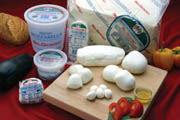
Eichten's Hidden Acres, Center City, Minn., recently rolled out Wild Rice Gouda. That's right, cheese with rice. Toasted wild rice adds an unexpected flavor and texture to creamy-textured Gouda cheese. The nutty, semi-soft cheese has a mellow flavor and a tangy finish.
Convenience is another trend that continues on an upward trajectory. The delicious part is that the concept has expanded well beyond the realm of American sandwich singles and string cheese. According to data from Information Resources Inc., natural cheese slices showed the greatest growth in retail of all forms of cheese last year.
"Today, it's all about interesting, ready-to-use blends such as three- and four-cheese blends and ethnic-style cheese blends, as well as natural cheese spreads and specialty cheeses in pre-sliced, sandwich- and entertaining-ready forms," says Tanyeri.
Let's not forget the trend in delis and sandwich shops, including innovative chains such as Quiznos® Sub. Today's sandwiches have undergone a remarkable transformation with emerging sandwich stars such as creamy fresh mozzarella, smoked Cheddar, piquant aged Provolone, Asiago, feta, Brie, Muenster and robust Gorgonzola.
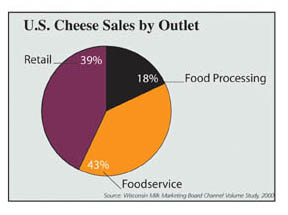
When it comes to cheese being used in foodservice, there has traditionally been the belief that cheese sales were almost equally distributed among retail, food processing and foodservice outlets. Things have changed. Keep in mind that it's not like less cheese is going into food processing (i.e., frozen entrees, jarred pasta sauces, etc.), it's that so much more is sold through retail and foodservice, with foodservice possessing a whopping 43% share of cheese sales.
In late 2003, the California Milk Advisory Board (CMAB) surveyed 105 leading restaurants in and around San Francisco and the Napa and Sonoma wine regions to determine the role fine cheeses play on today's restaurant menu, as well as how cheese is featured. CMAB found that cheese is featured throughout the restaurant-from an ingredient in appetizers and main dishes, as well as on cheese plates.
Today, 83% of restaurants named fine cheeses as an ingredient or a cheese offering on the appetizer menu compared to just 19% in 2000. Cheeses are also frequently listed as an ingredient in salads and other starter plates. In addition, 62% of restaurants name cheese as a main dish ingredient; 34% list them at end of menu, notably as a cheese course; and 20% on the dessert menu.
"We also found that more than half of the chefs are featuring the names of cheeses and producers in offerings ranging from appetizers to desserts," says Nancy Fletcher, CMAB's v.p. of communications. "Identifying fine-handcrafted cheese by name and by producer says that the chef wants customers to know how much he cares about the quality of his ingredients."
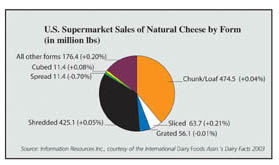
"Part of the reason more restaurants are featuring American specialty and artisan cheeses is because distributors are carrying more of the cheeses. Chefs are increasingly realizing that we produce a diverse array of fine cows milk cheeses in this country," says Fletcher. "Since 2000, the number of cows milk cheeses produced in California has grown from 160 to more than 200, and almost all of the new cheese have been specialty, artisan and farmstead types."
How can cheesemakers be actively involved with getting more of their cheeses on menus? BelGioioso Cheese Inc., Denmark, Wis., is helping chefs get creative with new Fresh Mozzarella Curd. The curd, which comes in 10- and 20-lb packages, enables operators to customize and develop their own varieties of mozzarella cheese through a hands-on approach. Chefs simply blend in seasonings and other ingredients of choice into the curd to create their own cheese.
Cheese use is booming in all types of restaurants, which makes sense, as according to DMI's 2003 Cheese Omnibus Study, 90% of consumers agree that adding cheese to a dish gives it more flavor.
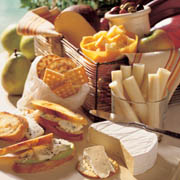
Cheddar and Hispanic-style cheeses are the most preferred cheeses on burritos and quesadillas, with almost three-fourths of all consumers preferring multiple cheeses on these Mexican foods. Indeed, the popularity of Hispanic foods, along with Hispanic cheeses, is at an all-time high. Manchego, asadero, queso blanco . . . all Hispanic cheeses, promise to become as familiar to the U.S. consumer as Cheddar and mozzarella.
"Hispanics are the fastest growing ethnic group in the United States," Tanyeri says. "And Hispanic foods are moving farther and faster than ever into the culinary mainstream."
You can't talk about cheese and not discuss the trend in organic. Though still a relatively small niche, organic dairy products, including cheeses, are among the fastest growing food categories. Consumer demand for products perceived to be healthful and natural is fueling the trend, as is cheesemaker and dairy producer interest in reaping the often significantly higher margins that organic products command. Wisconsin leads the country in the number of organic dairy farms, which is approximately 250, and its cheesemakers offer a wide variety of traditional and specialty cheese varieties that are certified organic.
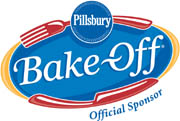
Deromedi nicely sums up what everyone involved in food manufacturing and marketing should be looking at, including cheesemakers. He says:
The growing importance of health and wellness has significantly altered consumption and buying behaviors. Low-carbs diets, concerns about trans fat and obesity, and greater demand for organic and natural products are requiring a shift in what we market and how we market it. The consumer demand for convenience has always been a driving factor in the food industry. But as the pace of life quickens, consumer expectations continue to rise, whether it's for ease of preparation, greater portability or the convenience of single-serve packages.
In conclusion, the cheese industry has some great wares to sell. The time is right for flavorful and convenience innovations. It's a natural for cheese.
Sidebar: Reduce Mold Growth and Extend Shelflife
In order to boost cheese sales for retailers and provide consumers with higher quality cheese products, Dairy Management Inc.™ (DMI) is leading research efforts to retard mold growth on the surface of cheeses.Researchers Joseph Marcy and John Koontz, both from Virginia Polytechnic Institute and State University in Blacksburg, Va., have identified a way to inhibit mold growth on the surface of cheeses by leveraging natamycin, an antimicrobial preservative approved by FDA for use in the food industry. Natamycin is particularly beneficial when used on shredded cheeses, which are especially prone to mold.
Early in their research, Marcy and Koontz pinpointed and are successfully addressing two potential challenges: Natamycin is practically insoluble in water and its stability is degraded during the ripening and storage of cheese.
Natamycin's tendency toward insolubility makes it difficult to apply to cheese surfaces. In its original form, natamycin is a dry powder that must be mixed in an aqueous solution to form a liquid that can be applied to food products. However, during that application process, aqueous natamycin suspensions can clog spray nozzles and prevent a uniform distribution of the substance onto the cheese surface.
Once the spraying hurdle is overcome, the second part of the challenge arises.
"In terms of stability, natamycin is extremely sensitive to ultraviolet light," says Marcy. "Cheese products are exposed to high-intensity fluorescent lighting in the retail dairy case, resulting in natamycin degradation on the cheese by the time of purchase by consumers."
Marcy and Koontz set out to increase the water solubility and chemical stability of natamycin to improve the delivery system and product quality of shredded cheese. The project was conducted with funding from DMI, the domestic and international planning and management organization that builds demand for U.S.-produced dairy products on behalf of America's dairy farmers.
Marcy and Koontz addressed these issues by forming molecular inclusion complexes of natamycin with cyclodextrins in order to increase its solubility and chemical stability.
"In these inclusion complexes, we found that more than 90% natamycin remained in the aqueous solution and it was significantly more stable than free natamycin," Marcy says. "When addressing the issue of stability, we found that product packaging helped to greatly reduce natamycin photodegradation."
Though the research is ongoing, the results to date are promising.
"The accomplishment of these objectives should dramatically increase the antifungal efficiency of natamycin and, therefore, allow consumers to purchase shredded cheese products of greater quality," concludes Marcy.
For more information on DMI's research on natamycin, call 800/248-8829 or visit www.extraordinarydairy.com.
Sidebar: A Look into the Future: Vatless Cheesemaking
The ancient practice of cheesemaking just got an upgrade using a new process that leverages a combination of membrane filtration systems and coagulators instead of the traditional vats that cheesemakers have relied upon for decades.This vatless system facilitates the production of mozzarella-type cheese on a continuous basis, enabling cheesemakers to meet growing consumer product demand while capturing the pure milk proteins that are becoming increasingly valuable in nutraceutical applications.
Researcher Syed Rizvi of Cornell University in Ithaca, N.Y., led the effort to create this novel cheesemaking process. The project was conducted in conjunction with the Northeast Dairy Foods Research Center (NDFRC), with funding from Dairy Management Inc.‘ (DMI).
In the traditional vat process, nine pounds of whey and one pound of cheese are produced from 10 pounds of milk. Cheesemakers then process the whey to create functional ingredients for food manufacturing, such as whey protein concentrate, isolates and others. Using microfiltration and a coagulator, Rizvi was able to efficiently produce a "zero" whey mozzarella-type cheese from a smaller quantity of microfiltered and concentrated skim milk.
"With the microfiltration process, dairy processors can filter liquid milk to remove serum proteins prior to using the milk in cheesemaking," says Rizvi. "Depending on whether the goal of the process is to make a concentrated milk-derived food ingredient rich in protein, or to separate individual components from the milk, the filters can be adjusted accordingly, yielding a customized fluid permeate and a customized retentate."
Rizvi's microfiltration process produced a high-concentrate casein retentate, to which rennet and a starter culture were added. The resulting cheesemilk was then pumped into a coagulator and the curd was cooked, salted and stretched.
Emerging research indicates that milk-derived proteins may prove beneficial for weight management and the regulation of food intake, hypertension and muscle metabolism. New and improved fractionation methods, such as Rizvi's microfiltration process, provide a means to isolate the healthful components in milk and incorporate them into the new products that consumers are beginning to demand.
For more information about continuous cheese production via the new vatless system, contact DMI at 800/248-8829 or visit www.extraordinarydairy.com.
Sidebar: Anyway You Slice It
Researchers at the University of Wisconsin, Madison-Xiaochun Li, a mechanical engineering professor, and Hongseok Choi, an engineering graduate student-have identified a way to use a laser toslice cheese. They've adapted the same kind of laser used for eye surgery to slice cheese. Using a laser helps overcome the maintenance and care of large cutting machines. The laser used emits light in ultraviolet, and therefore short wavelengths. Called a cold laser, it
cuts by blasting apart the molecular bonds that hold materials together. Though still preliminary research, hopefully it will be economical to someday commercialize this technology.

Sidebar: Marth Receives NCI Laureate Award
At the 2004 Dairy Forum, the National Cheese Institute (NCI) awarded its highest honor, the NCI Laureate Award, to Elmer Marth, professor emeritus of the University of Wisconsin, Madison. NCI Chairman Lou Gentine, chairman and CEO of Sargento Foods, Plymouth, Wis. (pictured far left), presented the award to Marth for his lifelong dedication to researching and teaching cheese safety. (Phyliis and Elmer Marth are pictured in the center, with IDFA President and CEO Connie Tipton at the far right.)The NCI Laureate Award recognizes individuals who have made significant contributions to the development and growth of the industry. A panel of industry professionals chooses a winner each year based on a person's long-term contributions to the industry.
Marth "truly personifies the spirit of this award," said Gentine during the award presentation. "His groundbreaking research is a key reason that the cheese industry enjoys the excellent food safety record that it has today."
Marth's life has centered on dairy since his birth, which took place on a dairy farm in Jackson, Wis. He earned three degrees (B.S., M.S. and Ph.D.) from the University of Wisconsin, Madison, in bacteriology with a focus on food and dairy science.
After receiving his Ph.D., he served as a bacteriology instructor at his alma mater for three years. In 1957, he married his wife, Phyllis, and moved to Kraft Foods' R& D team in Glenview, Ill., where he conducted microbiological research for more than eight years. His love of teaching lured him back to University of Wisconsin. Today, Marth is still involved with the university and continues to publish industry guidance and serve as a food safety consultant.
Marth's research included studies on salmonella in cheese, the behavior of aflatoxin M1 during the manufacture and storage of cheese and behavior of Listeria monocytogenes during various types of cheesemaking. Throughout his career he has authored or co-authored more than 660 scientific publications, including the books Applied Dairy Microbiology, Dairy Foods Safety and Listeria, Listeriosis and Food Safety. In 2003, Marth worked with the Wisconsin Milk Marketing Board to review and edit The Wisconsin Cheese Food Safety Manual, which is now being distributed to all state cheese plants.
Marth now joins the ranks of cheese industry pioneers who have won the NCI Laureate Award, including Max Gonzenbach, Rudy Nef, Don Menzner, Betsy Holden, Don Storhoff, Lester Kielsmeier, Hans Epprecht, Norm Olson, Vince Zehren, Jack Budahn, Leonard Gentine Sr., Raymond Goldbach, Harold Steinke, John H. Nelson and Dave Nusbaum. NCI will call for nominations for the 2005 NCI Laureate Award this fall.